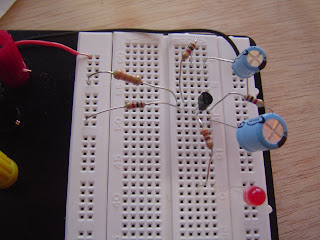
Back on January 13th, I created a small contest asking readers to help me understand better the circuit seen in Figure 2-60 on page 59. I was having difficulty understanding how the circuit was working... mainly because my limited training in electronics was always about closing a circuit. I could NOT, for the life of me, see how the circuit was closed in Figure 2-60. With the pushbutton open, I saw no closed loop.
But the circuit in Figure 2-60 isn't drawn like a typical circuit. The positive and negative voltage terminals are not drawn together. That's what took me a bit to see... and once I did, I saw the loop. See, in most circuits I'd seen or drawn, the battery (or power) was always drawn with the same symbol... current came out one end and went back in the other... there's your loop.
But with 2-60, the closed loop is there... it's just not drawn that way. You can, for all practical purposes, consider the small black dot just to the right of the big red + sign and the other black dot to the left of the big - sign as touching... if you do that, the circuit is closed.
Okay, enough of that... to the winners. Well, I only had two submissions... so this is an easy one. Both Brian and Nick will each get a Maker's Notebook.
Brian and Nick: I need you to email me at jktechwriter *at* gmail dot com with your mailing addresses... in order to confirm you are who you say you are, I'll email you instructions for confirming you were the person who posted the item. I wouldn't want to send a book to another Brian or Nick!
And now another contest - for this one, I'll be picking two winners - each will receive a Maker's Notebook. This contest is about helping out Charles Platt, author of the Make: Electronics book, and MakerSHED. Here's all that you need to do:
1. Add a comment to THIS post - January 31, 2010 "Contest Winners - and a New Contest."
2. Your comment should be between 50 and 100 words.
3. Let Charles and/or MakerSHED know your thoughts on the book - tell them what you like, what you dislike, or what other books/projects you'd like to see from MakerSHED.
That's it - I'll pick two winners randomly on Feb 13, 2010 so I can award two Maker's Notebooks on Valentine's Day. I'll number all the comments, write down each number on a paper chit, and have my wife pull two numbers randomly from a hat. Two minutes of your time for a chance to win a $20 Maker's Notebook. USA residents only, please.

















































